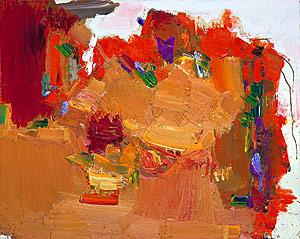It's Throwback Thursday! And we at Eye Level have decided it's a great opportunity to bring back some of our interesting posts from the past. American Art has been publishing our blog since September 2005 (that's an eternity in Internet years) and some of our posts are as current now as the day we first posted them. Today, we feature a version of Howard's February 2008 post on Hans Hofmann's painting, Fermented Soil. You can see Fermented Soil on American Art's 3rd Floor, North Wing.

Hans Hofmann's Fermented Soil
Fermented Soil by Hans Hofmann contains such fresh joy and vigor it is hard to believe it was painted by a man in his mid-eighties. It swings like a jazz sextet. Hofmann was right in the swim of what was going on in painting at that moment, and Color Field painting would have been impossible without his contribution.
Fermented Soil achieves the layers of poetry that Hofmann was in search of throughout his career. In fact, Hofmann would sometimes use a line from German poet, Rainer Maria Rilke, as a title. The famous push-pull that he emphasized in his teaching can be seen in this painting; the insistence on tension in composition achieved through the handling of paint and juxtaposition of color, like the interplay of notes or chords in music. In all those improvised strokes there is an assurance that can only come through the blood memory of painting for more than six decades. The color is pure Hofmann and comes from the many landscapes, figure studies, and still lifes he painted. His paint seems as edible as fruit.
Born in Germany, Hofmann first came to America in 1930 as a mature artist. He taught many students who would become important painters, including Frank Stella, Helen Frankenthaler, and Lee Krasner. There is an implicit connection through Krasner to Jackson Pollock, who was her husband. Art critic Clement Greenberg would often visit Hofmann’s studio, and dialogues between the two men played a role in developing Greenberg’s thoughts on art.
Hofmann’s earlier work is marked by many influences, from Seurat and postimpressionism to Picasso and Matisse. When Hofmann was in his seventies and eighties and was able to stop teaching, his work came to fullest flower. His contact with the New York School enabled this Zen-like jump to a new plateau, where his lifetime of disciplined work and teaching allowed him to paint with the flow of a jazz improvisationist.

